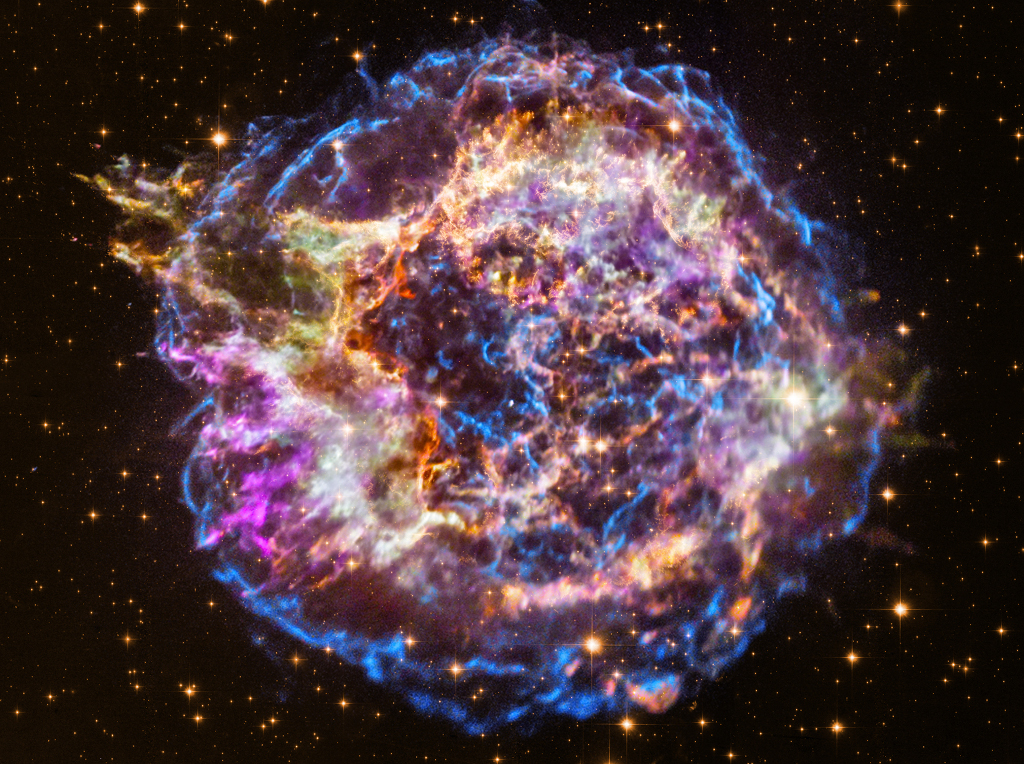2023年6月1日
Recycling Cassiopeia A
Image Credit: X-ray – NASA, CXC, SAO; Optical – NASA,STScI
Explanation: Massive stars in our Milky Way Galaxy live spectacular lives. Collapsing from vast cosmic clouds, their nuclear furnaces ignite and create heavy elements in their cores. After a few million years, the enriched material is blasted back into interstellar space where star formation can begin anew. The expanding debris cloud known as Cassiopeia A is an example of this final phase of the stellar life cycle. Light from the explosion which created this supernova remnant would have been first seen in planet Earth’s sky about 350 years ago, although it took that light about 11,000 years to reach us. This false-color image, composed of X-ray and optical image data from the Chandra X-ray Observatory and Hubble Space Telescope, shows the still hot filaments and knots in the remnant. It spans about 30 light-years at the estimated distance of Cassiopeia A. High-energy X-ray emission from specific elements has been color coded, silicon in red, sulfur in yellow, calcium in green and iron in purple, to help astronomers explore the recycling of our galaxy’s star stuff. Still expanding, the outer blast wave is seen in blue hues. The bright speck near the center is a neutron star, the incredibly dense, collapsed remains of the massive stellar core.
Tomorrow’s picture: massive galaxy
回收仙后座A
影像提供: X-ray – NASA, CXC, SAO; Optical – NASA,STScI
说明: 我们银河系内的大质量恒星,过着绚烂多彩的一生。它们从庞大的宇宙云中塌缩诞生出来,在其内的核子火炉点燃之后,就不停的在核心合成重元素。经过数百万年、当核燃料用完后,恒星发生爆炸把浓化过的物质抛回星际空间,成为制造下世代恒星的材料。上面影像里的这团名为仙后A的超新星扩张碎片云,就是恒星生命循环最后阶段的例证之一。虽然产生这个超新星遗迹的爆炸之亮闪,大约是在350年前出现于地球的天空中,不过它大约经过了11,000年才传到我们这里。这张整合钱德拉卫星X射线及哈勃太空望远镜可见光数据的假色影像,呈现仙后A遗迹内依然炽热的物质丝与物质结。依仙后A的估计距离来换算,这张清晰的X光影像大约涵盖了30光年的区域。影像以不同色泽呈现某些元素发出的高能辐射,其中矽辐射为红、硫辐射为黄、钙辐射为绿、而铁辐射为紫,以协助天文学家探索我们银河的恒星物质是如何被回收。此外,泛蓝的外环是仍在扩张的爆炸震波前沿。影像中心附近的亮斑则是中子星,为这颗大质量恒星之星核塌缩后所留下的无比致密天体。
明日的图片: massive galaxy



